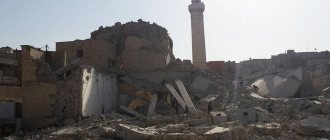Civilians under the control of American soldiers and doctors contemplate the bodies of Jewish women killed by the SS during the Holocaust in Czechoslovakia.
Crimes against humanity
- or
against humanity
- are considered crimes of a particularly heinous and inhuman nature that are part of a general or systematic attack against the civilian population, carried out in furtherance of the policy of a state or organization. [1][][] Crimes against humanity are one of four classes of crimes considered most important by the United Nations for the international community, along with the crime of genocide, war crimes and the crime of aggression. Crimes against humanity committed against civilians include includes a range of crimes against people, such as murder, enslavement, rape and other serious acts of sexual violence, forced population transfers, torture, arbitrary detention, enforced disappearances, persecution of certain groups of the population, racial segregation and, in general, all actions committed with intent to cause great suffering or create a serious threat to the physical integrity or mental or physical health of the victims. In 1968, the Convention on the Inevitability [4] of war crimes and crimes against humanity. A number of countries have determined that they cannot be subject to amnesty or other forms of leniency established by law. [ 5 ]
For the prosecution of crimes against humanity, there is the principle of universal jurisdiction, according to which any state can prosecute and criminally convict their perpetrators, regardless of the place where they were committed, since by their very nature the victim is a victim. The international community and humanity as such . [6] Despite this, in many cases defendants and the countries to which they belong have successfully argued that the principle does not apply to their case. In 1998, the International Criminal Court (ICC) was created with the responsibility to prosecute crimes against humanity, genocide, war crimes and the crime of aggression. By the principle of complementarity, the jurisdiction of the ICC coincides with the jurisdiction of national states. The ICC does not have the support of the world's major military powers, such as the United States, Russia and China.
Historical evolution
Main article: Genocide
The crime of genocide, which is also considered a crime against humanity, is absolutely necessary.
The London Agreement of 8 August 1945, which established the Nuremberg Tribunal Statute, defined as "crimes against humanity" "murder, extermination, enslavement, deportation and any other inhumane acts against the civilian population, or persecution for religious, racial or political reasons when the said acts or prosecutions are committed in connection with any crime against peace or any war crime.”
In 1946, the United Nations General Assembly reaffirmed the principles of international law recognized by the Tribunal's Statute and proclaimed Resolution 96(I) on the crime of genocide, which it defines as "the denial of the right to subsistence to entire groups of people." , including “racial, religious or political”, calling for the necessary measures to be taken to prevent and punish this crime.
This resolution was embodied in the Convention on the Prevention and Punishment of the Crime of Genocide, adopted by the United Nations General Assembly in its resolution 260 A (III) of 9 December 1948 and which entered into force in 1951.
The definition of genocide contained in the 1948 Convention was adopted in Article 4 of the 1993 Statute of the International Criminal Tribunal for the Former Yugoslavia, Article 2 of the 1994 Statute of the International Criminal Tribunal for Rwanda and Article 7 of the 1998 Rome Statute, which created the International Criminal Court.
Illegal armed groups
Participation in hostilities on the territory of a country by a person who is not its citizen and does not serve in its army is classified as mercenary activity. Article 359 of the Criminal Code of the Russian Federation provides for various types of liability for this, depending on the corpus delicti:
- For recruiting and providing material support for mercenaries - up to 8 years in prison.
- For the same actions committed with the help of official position – up to 15 years.
- Participation of a mercenary in hostilities is up to 7 years.
The main criterion for mercenaryism is receiving money for participating in hostilities.
Types of crimes
According to the Rome Statute, the following acts may be considered crimes against humanity:
- Murder: Premeditated murder.
- Genocide: The systematic extermination of one or more social groups motivated by issues of race, religion, ethnicity, language, eugenics, sexual orientation, socioeconomic status, social class, politics, ideology, culture, or nationality. This is mass murder aimed at destroying a group, which may even include measures to prevent new births in persecuted groups.
- Ethnic cleansing: the systematic destruction of ethnic and/or racial groups in a given territory in order to make the territory ethnically homogeneous and maintain ethnic superiority. Methods used: direct expulsion, genocide, deportation and destruction of property.
- Terrorism: A violent form of political struggle that seeks to destroy the established order or create an atmosphere of terror and insecurity that may intimidate opponents or the population at large.
- Slavery: The exercise of property rights over a person, including trafficking in persons, especially women and children.
- Deportation or forced transfer: The removal of people from an area where they are legally present, without reasons permitted by international law, with the understanding that deportation involves crossing national borders and forced removal occurs within them.
- Imprisonment or other serious deprivation of physical liberty in violation of fundamental rules of international law.
- Torture: Serious pain or suffering, physical or mental, intentionally inflicted on a person while the accused was under his/her care or control. These include cases of medical torture, an example of which is forced experimentation on humans.
- Rape, sexual slavery, forced prostitution, forced pregnancy, forced sterilization, or other sexual violence of comparable severity. Rape and other sexual abuse may also constitute crimes within the Court's jurisdiction as torture because they constitute a crime against humanity or a war crime.
- Persecution of a group or collectivity with its own identity on political, racial, national, ethnic, cultural, religious or gender grounds or for other reasons generally recognized as unacceptable under international law, in connection with any crime included in the Statute. Persecution refers to the deliberate and serious deprivation of fundamental rights in violation of international law because of the identity of a group or community. It is punished in connection with another act that constitutes a crime against humanity, a war crime or genocide.
- Enforced disappearance of persons: the detention or abduction of persons by a state or political organization, or with their sanction, consent or acquiescence, together with the refusal to acknowledge the deprivation of liberty or to provide information about the fate of the "disappeared" person, with the intention of depriving them of the protection of the law for an extended period.
- Crime of Apartheid: Inhumane acts committed in the context of an institutionalized regime of systematic oppression and domination of one racial group over another for the purpose of maintaining that regime.
- Other inhumane acts of a similar nature which intentionally cause great suffering or harm to physical integrity or mental or physical health: inhumane acts of the same gravity as other crimes against humanity.
The role of the humanitarian legal field
Modern humanitarian law plays a fairly important role in the formation of the general institution of crimes organized and carried out against humanity. It has the following important goals:
- Establishment of special rules and mandatory standards of behavior characteristic of participants in the conflict. This is necessary in order to ensure freedom and human rights.
- Relieving the suffering of people who have become victims of confrontations.
- Protecting the population from various disasters that can be caused by wars.
- Identification of unacceptable methods of organizing and conducting military manipulations.
The humanitarian area of law in such a case acts as a source of classification of illegal military operations. Here, violations directed solely against humanity and based on certain principles and standards of internationally established law are considered and studied.
Responsibility for organizing and implementing actions against humanity is based on concepts and classification categories developed specifically by humanitarian law.
These are effective tools for protecting modern civilians!
The process of studying and classifying violations organized against humanity cannot be done without the foundations of criminal law. It is required for the effective formation of the optimal level of human responsibility for encroachments on legal relations established and regulated by modern humanitarian law. This goal is achieved due to such important factors as:
- Determination and fixation of the structure of regulations relating to violations of the law of a military nature.
- Recording illegal operations aimed solely against humanity.
The listed actions should relate to various armed military clashes taking place both at the international and domestic levels.
List of crimes against humanity by death toll
| List of crimes against humanity | ||||||
| Example of a crime against humanity | Location | start date | Final date | Lowest death toll estimate (excluding denial) | Highest death toll estimate | Other statistics |
| Arab slave trade | Western Asia, North Africa, East Africa, India and Europe | 700 s | 1899 | 7 545.000 -(1500 — 1899) [ 8 ] | 70,000,000 -(700s-1899) [9] | |
| Massacres under Ranavalona I | Madagascar | 1833 | 1839 | 2 500 000 [ 10 ] | 2 500 000 | Half of Madagascar's population died [10] |
| Late Victorian burnt offerings | India, China, Brazil, Ethiopia, Korea, Vietnam, Philippines and the island of New Caledonia. | 1876 | 1902 | 30 000 000 | 60 000 000 | |
| Massacres under Chiang Kai-shek | People's Republic of China | 1928 | 1946 | 5 965 000 [ 11 ] | 18 522 000 [ 11 ] | |
| Holocaust in Asia [12] | East Asia and the Pacific | 1931 | 1945 | from 3,000,000 to 10,000,000 [13] | 30 000 000 [ 14 ] | |
| Nazi Holocaust | Territories occupied by the Third Reich during World War II (Germany, Poland, France, Hungary, Czechoslovakia, USSR, Yugoslavia, etc.) [15] | 1941 [ 16 ] | 1945 | 6 000 000 | 18 653 000 [ 17 ] | It is estimated that more than 6 million Jews died, but this figure does not include other victims of the Holocaust such as Soviet citizens, Poles, Serbs, the disabled, Gypsies, homosexuals, Jehovah's Witnesses, etc. see also Holocaust victims. |
| Great Leap Forward [ 18 ] | People's Republic of China | 1958 | 1961 | 11 600 000 [ 19 ] | 55 000 000 [ 20 ] | Frank Dikötter estimates that at least 2.5 million people were beaten or tortured to death, and another 1 to 3 million committed suicide. [ 21 ] The Great Leap Forward also resulted in the greatest destruction of real estate in human history, surpassing any of the bombings of World War II. [22] Approximately 30 to 40 percent of all houses were demolished. [23] Frank Dikötter argues that "houses were demolished to make fertilizer, build canteens, relocate villagers, straighten roads, make way for a better future, enticing or simply punishing their owners."[22] |
| Atlantic Slave Trade (Ma'afa) | Atlantic Ocean, New World - (America), Africa | 1500s | 1700s | from 2,000,000 to 5,000,000 [24] | 60 000 000 [ 25 ] | |
| Laogai | People's Republic of China | 1950 | 1979 | from 1,500,000 to 5,000,000 [26] | 27 000 000 [ 27 ] | 50 million passed through Laogai camps[28] |
| Three All Policy | China | 1941 | 1945 | 2 700 000 [ 29 ] | 2 700 000 | |
| Concentration camps of the Second Boer War | South Africa and Swaziland | 1899 | 1902 | 26 000 | 40 000 | During the war, English troops devastated and burned all property. Captured Boers (men, women and children) were moved to concentration camps, where approximately 20,000 people died. News of the inhumane treatment of prisoners by the British increased Britain's negative image in the international community. Some 116,572 Boer men, women and children were moved to concentration camps, as well as some 120,000 black Africans. Due to the harsh conditions in the camps, approximately 25% of the Boers (27,927 Boers, of whom 22,074 were children under 16) and 12% of the African prisoners (14,155, although some put the number as high as 20,000) died in the camps. |
| GULAG | Soviet Union | 1930 | 1953 | from 1,500,000 to 1,700,000 [30] | from 5,000,000 to 6,000,000 [ 31 ] [ ] [ ] | 18 million people sent to the Gulag from 1930 to 1953. |
| Atrocities in Equatorial Africa[34] | French Equatorial Africa | 1899 | 1940 | 1 000 000 [ 34 ] | 13 000 000 [ 35 ] | 50% of the indigenous population died [35] |
| Great Purge | Soviet Union | 1936 | 1938 | 681 692 [ 36 ] | 1 704 230 [ 37 ] | |
| War crimes during the Soviet-Afghan War [38] | Afghanistan | 1979 | 1989 | 562 000 [ 39 ] | 2 000 000 [ 38 ] | |
| Cultural Revolution | China | 1966 | 1976 | 400 000 [ 40 ] | from 5,000,000 to 10,000,000 [41] | |
| Massacre in Indonesia 1965-1966 | Indonesia | 1965 | 1966 | 400 000 | 3 000 000 | |
| Concentration camps in North Korea [ 42 ] [ ] | North Korea | 1950 | this year | 400 000 [ 44 ] | 1 500 000 [ 45 ] | |
| Agent Orange | Vietnam | 1962 | this year | 400 000 [ 46 ] | 400 000 | Nearly 4.8 million Vietnamese were exposed to the chemical. [ 46 ] 500,000 Vietnamese children were born with deformities. [ 47 ] 1,000,000 Vietnamese contracted illnesses linked to the chemical. [48] |
| Massacres under Mengistu Haile Mariam [49] (Red Terror (Ethiopia), displacement and settlement in villages, famine 1983–1985) | Ethiopia | 1975 | 1985 | 225 000 [ 50 ] | 2 000 000 [ 51 ] | |
| Unit 731 | Harbin, Manchukuo (Japanese-occupied China) | 1935 | 1945 | 210 000 | 440 000 | 10,000 to 40,000 in institutions 200,000–400,000 outdoors |
| Atrocities against civilians during the Tambov uprising | Tambov, Voronezh, Saratov and Penza regions _ | 1920 | 1922 | 160 000 [ 52 ] | 160 000 | 50,000 civilians are interned in camps. [53] |
| Massacre of monarchists and Catholics during the Vendée War | Mainly el este de Francia: Vendée, norte de Sèvres (Poitou), sur de Maine et Loire (Condado de Anjou) and sur de Loira Atlantico (Brittany). | 1793 | 1796 | 127 500 | 160 000 | Residents of the Vendée: about 170,000 dead in total (75-80% monarchists and 20-25% republicans). [ 54 ] [ ] In total, about 170,000-200,000 dead. [56] |
| Nanjing massacre | Republic of China, Nanjing | 1937 | 1938 | 100 000 | 300 000 | 50% of the Chinese in and around Nanjing were killed. |
| Manila massacre | Manila, Philippines | 1945 | 1945 | 100 000 | 240 000 [ 57 ] | |
| Massacres under Idi Amin | Uganda | 1971 | 1979 | 100 000 | 500 000 | |
| Massacres led by the Lord's Resistance Army | Uganda | 1987 | present time | 100 000 [ 58 ] | 100 000 | In 2006, UNICEF estimated that the LRA had abducted at least 25,000 children since the conflict began. [59] |
| Genocide in Rwanda | Rwanda | 1994 | 1994 | 500 000 [ 60 ] | 1 000 000 | |
| Saudi Arabian war crimes during the Yemeni Civil War (2015–present) | Yemen | 2015 | this year | 92 701 | 93 000 | 84,701 [61] - 85,000 Yemeni children starved to death [62] 8,000 died in Saudi bombing [63] |
| Spanish Civil War | Spain | 1936 | 1945 | 58 000 [ 64 ] [ ] | 400 000 [ 66 ] [ ] | from 30,000 [68] to 300,000 [69] children stolen by the Franco regime |
| Bleiburg massacre | Austro-Slovenian border | 1945, mayonnaise | 1945, mayonnaise | 70 000 [ 70 ] | 100 000 [ 71 ] | |
| Ayacucho massacre | Peru | 1980 | 2000 | 69 000 | 82 000 | |
| War crimes during the Second Italo-Ethiopian War | Ethiopia | 1935 | 1936 | 62 000 [ 72 ] | 485 000 [ 72 ] | |
| Massacres under Francisco Macias Nguema | Equatorial Guinea | 1968 | 1979 | 50 000 [ 73 ] | 80.000 [ 73 ] | A third of the population of Equatorial Guinea died. |
| Condor Plan | Chile, Argentina, Brazil, Paraguay, Uruguay, Bolivia and sometimes Peru, Ecuador, Colombia, Venezuela | 1968 | 1989 | 50 000 [ 74 ] | 80 000 [ 75 ] | 400,000 prisoners [75] |
| Massacres under Hissene Habré | Chad | 1982 | 1990 | 40 000 [ 76 ] | 40 000 | 200,000 people, where they were also tortured [77] |
| Operation Polo | Hyderabad (herd) | 1948 | 1948 | from 30,000 to 40,000 [78] | 200 000 [ 79 ] | |
| Stalin's repressions in Mongolia | Mongolia | 1921 [ 80 ] | 1939 | from 30,000 to 35,000 [80] | 100 000 [ 81 ] | |
| Massacres under Francois Duvalier | Haiti | 1957 | 1971 | 30 000 [ 82 ] | 60 000 [ 82 ] | |
| 1991 riots in Iraq | Iraq | 1991 | 1991 | 25 000 | 180 000 | |
| War of Canudos | Bahia, Brazil | 1893 | 1897 | 24 850 | 25 000 [ 83 ] | Only 150 of the 25,000 members of the Canudos community survived government repression. |
| Elimination of dissidents in Syrian government detention centers [84] | Syria | 2011 | current year, 2014 | 11 000 [ 85 ] | 65 000 [ 86 ] | |
| Horror | France | 1792 | 1794 | 16 594 [ 87 ] | 16 594 | |
| Aztec sacrifices | Aztec Empire | 1400 | 1521 | 20 000 [ 88 ] | 5 000 000 [ 89 ] | |
| Peasant revolt in El Salvador. | Savior | 1932 | 1932 | 10 000 [ 90 ] | 40 000 [ 90 ] | |
| State terrorism in Argentina in the 1970s and 1980s | Argentina | 1976 | 1983 | 8000 | 30 000 | |
| Hastings massacre Kamuzu Banda | Malawi | 1966 | 1994 | less than 6000 [91] | 18 000 [ 92 ] | |
| Human rights violations by military dictatorship (Chile) | Chile | 1973 | 1990 | 212 | 3227 | |
| Massacres under the government of Hipólito Yrigoyen (Tragic Week and Rebellious Patagonia) | Argentina | 1919 | 1922 | 1100 [ 93 ] | 2856 [ 93 ] | |
| Hama massacre in February 1982 | Hama, Syria | 1982 | 1982 | 2000 | 10 000 | |
| False positives in Colombia | Colombia | 1988 | 2016 | 1,257 | 6.402 | |
| Matze genocide | Peru | 1964 | 1964 | |||
| Barrios Altos massacre | Peru | 1991 | 1991 | 15 | 15 | |
| Massacre at La Cantuta | Peru | 1992 | 1992 | 10 | 10 | |
| Santa massacre | Peru | 1992 | 1992 | 9 | 9 | |
| Massacre at La Cantuta | Peru | 1992 | 1992 | 6 | 6 | |
| Pedro Yauri | Peru | 1992 | 1992 | 1 | 1 | |
| Massacres in La Granja, El Haro, San Roque and the murder of Jesus Maria Valle Jaramillo. [ 94 ] | Colombia | 1989 | 1998 | |||
Crimes against human safety
This type of illegal actions includes various actions that violate the principles of humanity.
For example, justification of Nazism (Article 354.1 of the Criminal Code of the Russian Federation). If the culprit distorts historical facts, justifies the actions of Nazi criminals and denies the verdict of the international tribunal in Nuremberg, then he can be punished with a fine of up to half a million rubles or imprisoned for 5 years.
Have a question for a lawyer? Ask now, call and get a free consultation from leading lawyers in your city. We will answer your questions quickly and try to help with your specific case.
Telephone in Moscow and the Moscow region: +7
Phone in St. Petersburg and Leningrad region: +7
Free hotline throughout Russia: 8 (800) 301-39-20
Desecration of monuments and disrespect for memorable dates is punishable by a fine of 300 thousand rubles or correctional labor for up to a year.
This type of crime against humanity also includes a threat or attack against people under the protection of international organizations. For this, the offender can be imprisoned for 6 years. If the motive was the deterioration of international relations or the outbreak of war, then this will be recognized by the court as aggravating circumstances and the prison term will reach 10 years.
References
- United Nations (17 July 1998). "Rome Statute of the International Criminal Court". United Nations
. - Losada, Martin (2019). "two. Crimes against humanity". Crimes against humanity and genocide
. Viedma: National University of Rio Negro. pp. 33-52. ISBN 9789874960146. - UNHCR (9 May 2022). "Crimes against humanity, history's greatest atrocities".
- Royal Spanish Academy, ed. (2020). "Inevitability". Pan-Spanish Dictionary of Legal Spanish
. - Argentina and Guatemala are among the countries that have ruled that amnesties and other forms of leniency in cases of crimes against humanity are illegal. Myrna Mack Foundation (June 28, 2012). "An analysis of amnesty in Guatemala". Myrna Mack Foundation
.
CELS. “The last clause and due obedience laws are unconstitutional. Summary of the Nation's Supreme Court Ruling Resolving the Unconstitutionality of Forgiveness Laws." CELS
.
Argentina. “Law 27.362. Criminal behavior. Crimes against humanity, genocide or war crimes." . Infoleg
. May 12, 2022 - Macedo, Stephen, ed. (2001). Princeton Principles of Universal Jurisdiction. New Jersey: Princeton University. ISBN 0-9711859-0-5.
- "Convention on the Immunity of War Crimes and Crimes against Humanity" (undefined). Office of the United Nations High Commissioner for Human Rights
. - (1500 - 1599- https://remilitari.com/guias/victimario9.htm
- 1 000 000 — 1 300 000
115,000 - 180,000 (European Islamic slave trade)
(1600 - 1699 https://remilitari.com/guias/victimario8.htm
- 1 300 000
- 130,000 - 200,000 (trade in European slaves of Islam)
(1700 - 1799) - 2,000,000 https://remilitari.com/guias/victimario7.htm (1800 - 1899) - 3,000,000 https://remilitari.com/guias/victimario5.htm
Campbell, Gwyn (October 1991). "State and pre-colonial demographic history: the case of nineteenth-century Madagascar." Journal of African History. 23(3):415–445.
https://www.hawaii.edu/powerkills/CHINA.CHAP1.HTM
. Retrieved May 13, 2022.
. paragraph 111.
. ISSN 1134-6582. Retrieved May 13, 2022.
Frank Dikötter (2010). Mao's Great Famine: The Story of China's Most Devastating Disaster, 1958–62. pp. XI, XII
"Chapter II of Historical Military Sacrifice". De Re Military. Accessed April 17, 2022. https://remilitari.com/guias/victimario2.htm
https://necrometrics.com/20c100k.htm
Marek Sliwinski, "Afghanistan: The Extermination of a People", Orbis (Winter 1989), p. 39.
https://www.news.com.au/world/asia/vietnams-horrific-legacy-the-children-of-agent-orange/news-story/c008ff36ee3e840b005405a55e21a3e1
https://necrometrics.com/20c300k.htm#Eth35
https://web.archive.org/web/20080612161320/https://www.dangardner.ca/Featnov605.html
https://www.derechos.org/nizkor/doc/condor/calloni.html
Kaplonsky, Asian Studies (November 2000), review of Sandag and Kendall's Poisoned Arrows: The Mongol Massacres of Stalin and Choibalsan, 1921–1941: ca. 30,000–35,000 killed, 1921–41, most in late 1930s
Green, Ann (2001). "Haiti: Historical Setting § François Duvalier, 1957–71." In Metz, Helen Chapin (ed.). Dominican Republic and Haiti. Regional studies. Study completed December 1999 (3rd ed.). Washington, DC: Federal Research Division, Library of Congress. pp. 288–289. ISBN 978-0-8444-1044-9. ISSN 1057-5294. LCCN 2001023524. OCLC 46321054. President Duvalier ruled the country for fourteen years. Even in Haiti, where dictators were the norm, Francois Duvalier gave the term new meaning. Duvalier and his henchmen killed between 30,000 and 60,000 Haitians. The victims were not only political opponents, but also women, entire families, and entire cities. . . . In April 1963, when an army officer suspected of trying to kidnap Duvalier's two children took refuge in the Dominican Chancellery, Duvalier ordered the Presidential Guard to occupy the building. The Dominicans were furious; President Juan Bosch Gaviño ordered troops to the border and threatened to invade. However, Dominican commanders were reluctant to enter Haiti, and Boche was forced to turn to the [Organization of American States] to resolve the issue.
https://web.archive.org/web/20080521064730/https://dodgson.ucsd.edu/las/elsal/1902-1932.html
In "A Tragic Week", Silva said the total death toll was around 800 people who were never identified, while the US Embassy put a precise figure at 1,356 deaths.
Silva, Horacio Ricardo (2011). Red days, black summer
.
Buenos Aires: Anarres Books. p. 237. ISBN 9789871523146. ; Bilsky, Edgardo J. (1984). Tragic week
.
Political Library of Argentina 50
.
Buenos Aires: CEAL. paragraph 135. ISBN 950-25-0049-0. . In rebellious Patagonia, according to Archibaldo Lanus, anarchists spoke of 1,500 deaths, but it was probably between 300 and 400. Lanus, Juan Archibaldo (1988). The Argentine Case
. Buenos Aires: I started. paragraph 393 ..
_ Retrieved January 26, 2022.
Fight against criminal activities
In addition to the specialized organizations described above, other international organizations are also used to combat crimes against humanity.
UN and Interpol
These two organizations perform different tasks. The UN is a global association created to solve a wide range of international problems. Issues considered by various UN units also include military conflicts. Firstly, the UN Security Council makes decisions on military operations involving various countries. In addition, the United Nations itself has peacekeeping forces, which it sends to unstable countries to maintain peace and counter escalating conflicts.
The task of Interpol is to search and capture criminals who are on the international wanted list. These may include not only people who have committed criminal crimes, but also war criminals who organized genocide in a particular territory.
Bibliography
- Greffrey Robertson: Crimes against humanity.
The fight for global justice . 2008. - Criminalization of barbarism: International Criminal Court
/ co-author. Juan Antonio Carrillo Salcedo, 2000, ISBN 84-89230-24-2, pp. 301-324. - Rueda Fernandez, C.: Crimes under International Law: Classification and International Repression
. Editorial Bosch, Madrid, 2001. ISBN 84-7676-899-0.
- Corporate Responsibility for Crimes Against Humanity - Volume I
- Corporate Responsibility for Crimes Against Humanity - Volume II
- Diario del Juicio - Volume 1 - Complete chronicle of trials for crimes against humanity in Santiago del Estero.
- Trial Diary - Volume 2 - Complete chronicle of the crimes against humanity trials in Santiago del Estero.
| Control of authorities |
|
- Data: Q173462
- Multimedia: Crimes against humanity
Term
In the Ukrainian language, two parallel translations of the term are accepted - “crimes against humanity” and “crimes against humanity”. For example, in the Ukrainian version of the “Convention on the Non-Application of Statutes for War Crimes and Crimes against Humanity” the word “humanity” is used, and in the text of the “European Convention on the Non-Application of Statutes for Crimes against Humanity and War Crimes” the word “humanity”.
From a philological point of view, both terms are correct, but have slightly different meanings. Thus, “crimes against humanity” are crimes that harm a person - health, well-being, honor. They belong to the criminal category and are punishable by law. This is murder, incitement to suicide, beatings, torture, failure to provide assistance to a person in danger, unlawful imprisonment, hostage-taking, human trafficking, exploitation of children, rape, corruption of minors. But “crimes against humanity” pose a threat not to a specific person, but to the human community, the environment, violating the rules of human coexistence. They are punished not only by the laws of a given country, but also by international law. This is propaganda of war, planning and waging war, the use of weapons of mass destruction, piracy, hooliganism on the street, desecration of a grave, cruelty to animals, environmental pollution, the creation of a criminal organization, banditry, a terrorist act.
Thus, crimes against humanity are also crimes against humanity, but not all crimes against humanity are also crimes against humanity.






